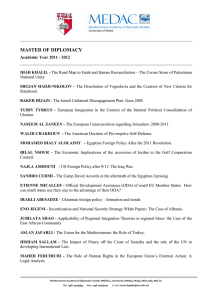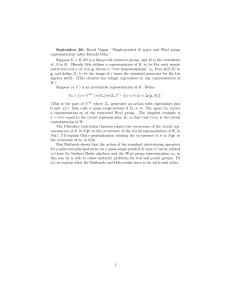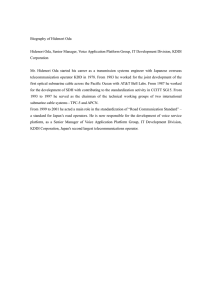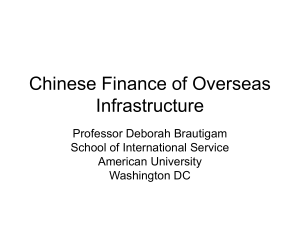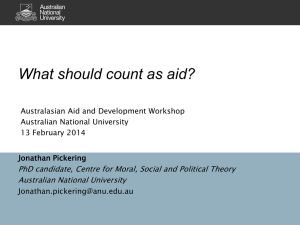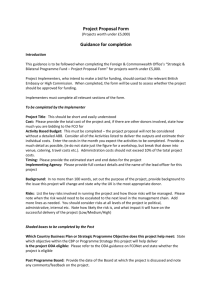“ The Japan ODA Model “ : RIETI seminar October 12, 2010
advertisement
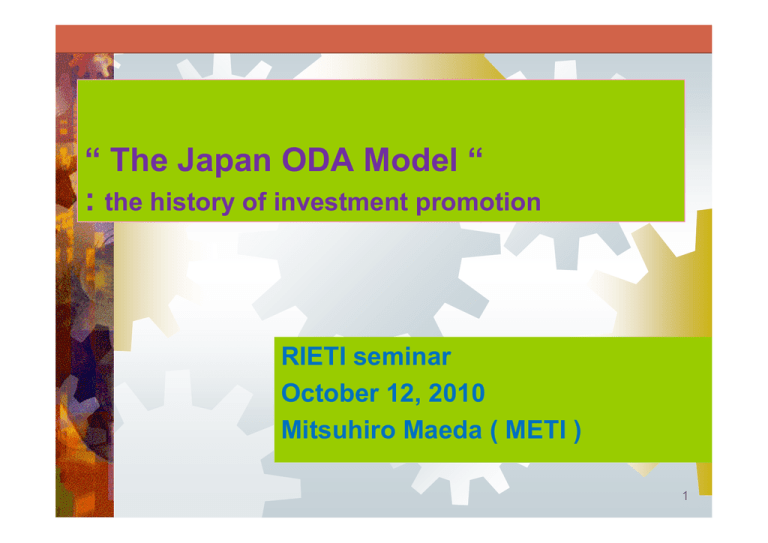
“ The Japan ODA Model “ : the history of investment promotion RIETI seminar October 12, 2010 Mitsuhiro Maeda ( METI ) 1 0. contents 1. the concept and the background of “ The Japan ODA Model “. 2. The history of international regimes of aid finance which had repeatedly forced Japan to change aid policies 3. Ideas of new schemes of aid finance ( developmental finance ) 2 1. The Japan ODA Model [ background ] In 2005, METI operated Working Group of Economic Cooperation, The National Council of Industrial Structure, in order to evaluate the half-century history of Japan’s aid policies. In 2005… - the Japanese society did not ( maybe still does not ) have a clear vision about the necessity of aid policies. - the Japanese government had been ( and still have been ) decreasing the ODA budget year by year. - under the Millennium Development Goals, major donors had been increasing their ODA significantly. Japan’s world-rank had been down graded from the world number one in 1990s to 2nd, 3rd, 4th, and 5th … - African countries had been ( and still have been ) calling “ trade, more than aid ! “ “ more and more investments ! ” 3 1. The Japan ODA Model [ Working Group of Economic Cooperation, The National Council of Industrial Structure 2005 analyzed the history of Japan’s aid policies as…] - The Japan’s economic cooperation in this half century was generally successful in helping especially Asian countries’ economic development. - The modality of Japan’s aid finance was unique comparing to other major donors. This uniqueness was, however, a main reason of remarkable effectiveness of Japan’s aid finance. This unique modality of Japan’s economic cooperation policies would be called “ the Japan ODA Model “. - The essence of “ the Japan ODA Model “ is establishing “ hyper-cycles “ between aid finance and direct investments of Japanese firms. Direct investments could play the main role of economic developments in developing countries. 4 1. The Japan ODA Model [ Hyper-cycle ] 1. Japan’s aid finance contributes infrastructure building in recipient countries. 2. That infrastructure attracts Japanese firms’ direct investments. 3. The investment ‘ rush ‘ of Japanese firms would cause congestion. And those Japanese firms would try to introduce upgraded technology. Thus those Japanese firms need higher level infrastructure. 4. Those Japanese firms request the Japanese government to help those countries in building higher level infrastructure. 5. Responding to that request, the Japanese government provides aid finance to those countries to build higher level infrastructure. 6. That higher level infrastructure attracts more direct investments of Japanese firms… 5 ODA provided to Asia and Africa mil. USD 20000 Africa Asia アフリカ 15000 アジア ※うち約4割が 東アジア向け 10000 5000 19 60 19 62 19 64 19 66 19 68 19 70 19 72 19 74 19 76 19 78 19 80 19 82 19 84 19 86 19 88 19 90 19 92 19 94 19 96 19 98 20 00 20 02 0 ※’Asia’ and ‘Africa’ : subject to the definition of OECD-DAC Asia includes middle east. Africa includes north Africa. (source: METI, according to OECD DAC ) 6 Private Direct Investment from OECD-DAC countries Asia ※more than 80% are East Asia Africa ※’Asia’ and ‘Africa’ : subject to the definition of OECD-DAC. Asia includes middle east. Africa includes north Africa. (source:METI, according to OECD-DAC) 7 1. The Japan ODA Model “ the Japan ODA Model “ would be described as such modalities… [ disputes on modalities of aid policies ] ① loan v.s. grant ② economic sector oriented v.s. social sector oriented ③ tied loan v.s. untied loan [ “ the Japan ODA Model “ ] ① loan rather than grant ② economic sector oriented rather than social sector ③ ‘ tied ‘ would be preferable 8 1. The Japan ODA Model [ The Japan ODA Model ] How and why the Japanese government had adopted that model without academic backgrounds at the beginning ? Q1. Why Japan had adopted a loan oriented policy ? Q2. Why Japan had adopted an economic sector oriented policy ? Q3. What factor had affected the Japan’s tied-untied modality ? 9 1. The Japan ODA Model [ hypothesis ] Q1. Why Japan had adopted a loan oriented policy ? A. The history matters. Q2. Why Japan had adopted an economic sector oriented policy ? A. The history matters. Q3. What factor had affected the Japan’s tied-untied modality ? A. The history matters. 10 1. The Japan ODA Model 1. Japan surrendered the World War 2 in 1945, and concluded the San Francisco Peace Treaty in 1951. Article 14 obliged Japan to pay reparations to Asian countries. 2. In order to pay reparations, the Japanese government established the Yen-loan system, utilizing FILP ( Fiscal Investment and Loan Program ). ( at that moment, the volume of Japan’s national budget could not afford paying reparations. ) Due to regulations of FILP, the financial scheme was ; Loan (not grant ) Yen basis (not USD) 11 1. The Japan ODA Model 3. In 1957, a big debate started about aid policies besides reparations. One side stated that Japan should not start aid policies, since Japan needed huge amount of money to build infrastructure inside. ( Japan got huge loans from the World Bank for Shinkansen, Tomei express Road… ) The other side, the Federation of Economic Organizations ( and MITI ) strongly advocated starting aid policies. 12 1. The Japan ODA Model 4. The original purpose of MITI’s aid policies was seeking for economic interests of Japanese firms in Asia. MITI “ the White Book on Economic Cooperation 1959 “ clearly stated ; Major powers ( US, USSR, GB, France, West Germany, PRC ) have been promoting “ competition of increasing influential power “ in the world society. Asian countries are important for Japan as markets and natural resources providers. A Japan’s main method to increase influence in Asia should be aid finance. Other major powers have already provided huge amount of aid finance as a method of increasing influence. Before other major powers would come to Asia, Japan should provide sufficient aid finance of infrastructure building in Asia to make Asian countries pro-Japan. The Federation ( and MITI ) persuaded LDP (Liberal Democratic Party ). Thus Japan’s aid policies started. 13 1. The Japan ODA Model 5. The competent authorities of Loan-type ODA had been ; MITI, MOFA, MOF and EPA 6. At the beginning, Yen loan was operated by EXIM. After establishment of OECF ( Overseas Economic Cooperation Fund ) in 1960, Jurisdiction disputes between EXIM and OECD had been continued until mid 1970s. - Yen loans for Japanese firms’ benefits were operated by EXIM Yen loans for social and economic development of recipient countries were operated by OECF.) ( in mid 1970s, LDP decided all Yen loans should be operated by OECF. ) 14 1. The Japan ODA Model 7. Since then, MITI has repeated the principle of “ trinity of trades, direct investments and aid finances “, strongly believing that this form would be the best in helping economic development of developing countries. ( without sufficient academic backgrounds ) ( “ a basic instinct “ of bureaucrats ? ) 15 2. International Regimes [ the Financial Geopolitics view ] 1. Historically, major donors have been creating and operating international regimes to regulate ( not promote ! ) aid finance, because aid finance ( precisely “ developmental finance “ including export credits also ) would significantly contribute to not only social and economic development of recipient economies, but also enhancing national interests of donor countries. *national interests of donor countries 1. Enhancing the status in the world society 2. Increasing economic benefits of donor countries’ firms 2-1. export promotion 2-2. investment promotion 16 2. International Regimes [ the Financial Geopolitics view ] 2. Not only incumbent major donor countries, but also some emerging powers would participate in this competition of increasing national interests. Such emerging powers would often create new types of aid finance ( developmental finance ) with more concessional conditions. 17 2. International Regimes [ the Financial Geopolitics view ] 3. Thus major donor countries would tend to create and operate international regimes in order to ; ① disarmament ( regulating excessive competitions ( chicken games ) of expanding aid finance for enhancing national interests ) D-regime ② containment of emerging powers ( banning new types of aid finance for enhancing national interests ) C-regime 18 2. International regimes 0. the original incumbent : U.K. financial scheme : export credits ( U.K. established ECGD in 1919 ) 1. [ D-regime Ⅰ] main incumbents : U.K. emerging power : continent European countries financial scheme: export credits (not new) conflict period : 1919 – late 1940s regime : Bern Union (1934) 19 2. International regimes 2. [ D-regime Ⅱ] main incumbents : major European countries emerging power : major European countries financial scheme : export credits and aid finance conflict period : late 1940s – 1960 regime : OEEC ( Organization of European Economic Cooperation ) (1948) DAG (Developmental Assistance Group) (1960), OECD (1961) 3. [ failed C-regime , D-regime Ⅲ] main incumbents : major European countries emerging power : U.S. financial scheme : market based export credits conflict period : late 1940s – 1978 regime : the OECD Export Credits Guideline (1978) 20 2. International regimes 4. [ failed C-regime ] main incumbents : major Western countries emerging power : USSR financial scheme : ‘Allowance in Repayment’ credits conflict period : late 1940s – early 1980s regime : (cold war) 5. [ C-regime Ⅰ] main incumbents : U.S., U.K. emerging power : France financial scheme : mixed credits (export credits + grants (ODA)) conflict period : early 1980s regime : amendment of the definition of ‘ tied-aid credits ‘ of the OECD Export Credits Guideline (1985) 21 2. International regimes 5. [ C-regime Ⅱ] main incumbents : U.S., U.K. emerging power : Japan financial scheme : Yen-loan type ODA (tied) conflict period : late 1980s – early 1990s regime : Wallen Package (1985), Helsinki Package (1991) of the OECD Export Credits Guideline 6. [ C-regime Ⅲ] main incumbents : OECD emerging power : Brazil financial scheme : (WTO Panel on export credits) conflict period : late 1990s - 2007 regime : amendment of the OECD Export Credits Guideline (2003) Sector Understanding of Aircraft (2007) 22 2. International regimes 7. [ C-regime Ⅳ? or failed ? ] main incumbents : OECD emerging power : China financial scheme : Various tied loans and Sovereign Wealth Funds? conflict period : 2000s – now regime : (under struggling) 23 2. International regimes [ how international regimes had forced Japan to change aid policies ? ] Japan started aid finance ( Yen-loan ) policies with tied conditions. MITI had been insisting on “ tied ” , and been successful in persuasion of other authorities until 1988. Affected by 6 times changes of international regimes ( 2-6 were the settling and amendments of OECD Export Credit Arrangement ), Japan had drastically decreased tied condition aid loans ( increased untied condition aid loans ) since 1987 ( in 1996, 100% was untied ). Japan officially announced a policy change ( tied to untied ) in 1988. Japan again officially announced a policy re-change ( untied to tied ) in 1997, however due to C-regimes, the total volume of tied aid loans has been remaining small. 24 2. International regimes [ main revisions of ' the Arrangement ' ] 1. initial ' the Arrangement ' ( Apr 1978 ) [ change-2 ] 2. Expansion of notification ( Nov 1981 ) 3. Introduction of prohibition of tied aid ( May 1985 ) [ change-3 ] 4. Expansion of prior notification And change of the definition of ‘ tied ’ ( July 1985 ) [ change-4 ] 5. Wallen Package Agreement ( July 1987 ) [ change-5 ] 6. Helsinki Package Agreement ( Dec 1991 ) [ change-6 ] 7. Schaerer Package Agreement ( July 1994 ) - on export credit only 8. Knaepen Package Agreement ( June 1997 ) - on export credit only 9. Nygren Package Agreement ( Sep 2003 ) - mainly on export credit 10. Agreement on Untied Aid Transparency ( Nov 2004) 25 2. International regimes 1.Initial ' the Arrangement ' ( Apr 1978 ) a. Trigger : US's initiatives. b. Principle : ' the Arrangement includes tied and ' untied ' aid c. Impact on Japan : no prohibition on tied aid. No regulation on untied aid. tied aid untied aid GE(%) 100 no regulation 25 15 0 ex-ante notification ex-post notification 26 2. International regimes 2.Expansion of notification ( Nov 1981 ) a. Trigger : Mixed finance ( grant plus export credits ) by France and Italy. b. Principle : introduction of ex-ante notification with consultation c. Impact on Japan : not significant Tied aid untied aid GE(%) 100 ex-post notification 25 15 0 ex-ante notification ex-ante notification with consultation 007 27 2. International regimes 3.Introduction of prohibition of tied aid ( May 1982 ) a.trigger : mixed credit finance b.principle : introduction of prohibition of tied aid c.impact on Japan : not significant Tied aid untied aid GE(%) 100 ex-post notification 25 20 0 ex-ante notification prohibition 28 2. International regimes 4.Expansion of notifications ( July 1985 ) a.trigger : US congress ordered US-EXIM to strengthen OECD regulations. b.principle : introducing notification system on untied aid. c.impact on Japan : not significant tied aid untied aid GE(%) 100 ex-post 50 25 0 50 ex-ante prohibition 053 A援助信用 29 2. International regimes 4.Change of the definition of ‘ tied ‘ ( July 1985 ) a.trigger : US congress ordered US-EXIM to strengthen OECD regulations. b.principle : definition change ( LDC-untied should be regarded as ‘ tied’ ) c.impact on Japan : significant tied aid untied aid GE(%) 100 ex-post 50 25 0 50 ex-ante prohibition 053 A援助信用 30 2. International regimes 5.Wallen Package Agreement : first stage ( July 1987 ) a.trigger : Japan offered LDC untied aid ( regarded as tied ) finance to Turkey on the second Bosporus Bridge. PM Thatcher politicized this issue. b.principle : introduction of ' concessionality level ' in stead of ' grand element ' as discount rate. c.impact on Japan : absolutely crucial. Biggest defeat. Surrender without conditions. CL(%) 100 50 30 0 tied aid untied aid ex-post 50 ex-ante prohibition 31 2. International regimes 5.Wallen Package Agreement : second stage ( July 1988 ) CL(%) 100 50 35 0 tied aid untied aid ex-post 50 ex-ante prohibition 32 2. International regimes 6.Helsinki Package Agreement ( Dec. 1991 ) a.trigger : US initiatives b.principle : introduction of ' commercial viability ' principle c.impact on Japan : serious, after launching re-tied policy in 1997 tied aid untied aid CL(%) 100 ex-post 80 80 consultation procedures 50 50 35 ex-ante prohibition 0 200mil SDR 200mil SDR 33 2. international regimes 1. The 1st change (1970) result : OECD-DAC’s adoption of the general untying principle initiators : Northern European countries impact : siginificant, rollback (Understanding on LDC Untied (1974)) *Japan-tied : only Japanese firms can participate in the bid of Japan’s ODA projects. *LDC untied : only Japanese and developing countries’ firms can participate in the bid of Japan’s ODA projects. *general untying : abolishing all restrictions of nationalities of participating firms in the bid of Japan’s ODA projects 2. The 2nd change (1978) result : inclusion of tied-aid credits in the OECD Export Credits Arrangement initiator : U.S. impact : no substantial impact at that moment (no prohibitions nor regulations, just information sharing) 34 2. International regimes 3. The 3rd change (1985) result : introduction of prohibition clauses of tied-aid credits in the OECD Export Credits Arrangement initiators : U.S., U.K. impact : no substantial impact at that moment (prohibited only below GE25% loans.) 4. The 4th change (1985) (significant ) result : change of the definition of ‘ tied ‘ ( LDC untied would be regarded as tied ) initiators : Europeans impact : increase concessionalities of LDC untied loans 35 2. International regimes 5. The 5th change (1987) (significantly serious) result : Wallen Package offence : initially U.K. after Bosporus 2nd Bridge U.S. , France impact : significant change of Japan’s ODA policy ( policy change from ‘ tied ‘ to ‘ general untying ‘ ) ( the 4th mid-term policy of ODA expansion (1988)) 6. the 6th change (significantly serious after 1997) result : Helsinki Package (1991) offence : U.K., Canada impact : no substantial impact at that moment ( Japan was promoting general untying after 1988 policy change ) significantly serious after Japan’s re-change of aid policies ( ‘ general untying ‘ to ‘ tied ‘ ) in 1997 36 3. New ideas ? [ agenda setting ] among many important problems on developmental finance, picking up only ‘a volume problem’ ‘a debt sustainability problem’ ‘an allocation problem’ 37 3. New ideas? [ ‘a volume problem’] : The all developing countries’ total demand of infrastructure building amounts to tremendously huge volume. The total volume of ODA is far below to meet the demand. ( DAC (22 countries) total ODA (2008) : 119.6 bil. USD ) : Japan has been constantly and significantly decreasing ODA budget year by year in 21st century. We can hardly expect future drastic expansion of ODA budget under the recent Japanese economic situation. 38 The World Bank estimates the annual demand for infrastructure construction (including maintenance and operation) in East Asia from 2005 to 2010 at more than $200 billion. USD(billion) 240 220 200 180 160 140 120 100 80 60 40 20 0 港湾・空港・橋梁・都市交通・ガス供給網等 ports, airports, gas grids, etc. 電力・道路・通信・上下水道・鉄道 power, roads, water and sewage, etc. Source: ”Connecting East Asia: A New Framework for Infrastructure (JBIC, ADB,World Bank) 39 3. New ideas? [‘a debt sustainability problem’] : In order to meet huge amount of demand, developmental finance often has been provided in the form of loan and caused an accumulated debt problem in many developing countries. : An accumulated debt problem has caused serious economic crisis in many developing countries many times, thus donor countries have been forced to reschedule or exempt their credits again and again. →IMF signaling system 40 3. New ideas? [‘a debt sustainability problem’] The history of Paris Club debt rescheduling schemes 1988 Toronto Term (33% reduction for LLDC) 1990 Houston Term (rescheduling for low and medium income countries 1991 London Term (50% reduction for LLDC) 1994 Naples Term (67% reduction for LLDC) 1995 Lyon Term (HIPC Initiative) 1999 Koln Term (expanded HIPC Initiative) 2000 Okinawa Initiative (100% reduction for HIPC) 2003 Evian Approach 41 3. New ideas? [‘an allocation problem’] = an allocation principle : Developmental finance should be provided to projects with big externalities. : In reality, politically important projects would often be preferentially promoted without considering economic externalities. = politicization in allocation →a deterioration of ‘a debt sustainability problem’ →invites corruption The issue is; : avoiding politicization : establishing an appropriate allocation principle 42 3. New ideas? Expansion of ODA strategy : Major donors (US, UK, France, Germany, Italy) are successfully increasing ODA volume. US : Millenium Challenge Account : Japan has been significantly decreasing ODA volume. : the Japanese government has been making big campaign of ODA expansion, recently started emphasizing economic interests. 43 3. New ideas? Expansion of ODA strategy [problems solution] 1. ‘a volume problem’ still remains (besides the fact that ODA expansion is hard…) a definition problem (1968) : ODA volume is officially shown in net-basis (disbursement minus repayment) : recently Japan disburses nearly 10 bil. USD every year but almost zero or minus in net-basis : minus (repayment surplus) will expand : in around 2020, Japan will be ‘a net ODA recipient’? 2. ‘a debt sustainability problem’ still remains 3. ‘an allocation problem’ still remains. recent movements : expanding Program Loans, instead of Project Loans → consideration of national interests ? 44 3. New ideas? Some new ideas have been already shown such as… IFF (International Financial Fund ) UK, 2003 : securitizing commitments by major donors : 50 bil. USD for mainly sub-Sahara Africa ( based on ‘a big push theory’ ) - Tobin Tax France, 2003 : taxation on FX, air fuel and air tickets : 50 bil. USD 45 3. New ideas? ABMI Asian Bond Market Initiative should be substantially promoted : ABMI advocated in 2000 : the rationale is solving ‘the double mismatch’ (currency and maturity) which is deemed as a main cause of the Asian Financial Crisis in 1997. : adopted as official agenda of ASEAN plus 3 (Japan, China and Korea) Financial Ministerial Meeting in 2002 :EMEAP (Executives’ Meeting of East Asia Pacific Central Banks ) established ABF (Asian Bond Fund)-1(national bond) in 2003 and ABF-2 (governmental organization bond) in 2004. : in future ; ABF-3 (corporate bond) ABF-4 (project bond) 46 3. New ideas? A new paradigm ? 1. Should we think about a comprehensive framework of developmental finance ? ( should we re-examine the concept of ODA ? ) ( should we NOT stick to follow the concept of ODA too much ? ) 2. Should we invite broad participation of private firms and citizens in the field of developmental aid ? PPP : Public Private Partnership would be the key concept. PPP1.0 : collaboration between nation state governments and private firms ( normal PPP ) PPP2.0 : collaboration among nation state governments, private firms and empowered citizens ( advanced PPP ) 47 3. New ideas? the Post-ODA based categorization of developmental finance? ODA based categorization (est. 1968 in OECD) developmental assistance ODA bilateral grant loan technical assistance multilateral OOF PF *not including recently developed financial technology *hardly thinking that non-governmental entities would take an important roles *reflecting aid activities at that time ( i.e. technical assistance as grant) 48 3. New ideas? the Post-ODA based categorization of developmental finance developmental finance equity loan corporate project sovereign sovereign guarantee non-sovereign sovereign sovereign guarantee non-sovereign guarantee grant 49 3. New ideas? PPP1.0 collaboration between nation state governments and private firms [background] : ‘a small government’ policy, NPM (New Public Management) under the Thatcher administration [definition of PPP1.0]( METI 2004 ) supplying goods or services with high externalities, such as infrastructure, by the private sector under the condition that the government would make the market enhancement measures, such as providing viability gap finances 50 viability gap Yen-loan viability gap ←Yen-loan type ODA ( market enhancement measures ) debt ←private finance (loan, or securitization) equity ←private (recipient government)51 3. New ideas? PPP1.0 collaboration between nation state governments and private firms [rationale of viability gap finance] : finance by nation state governments (ODA) only covers the viability gap portion. : in an ordinary project, a viability gap portion consists of 10 – 20% of the total project cost. : thus a donor could contribute 5 – 10 times more number of projects with the same amount of ODA 52 Mega Project Finance Initiative Japan Origin Country 3rd Countries, MDBs Insurance -in case of securitization Viability Gap ODA (Market enhance -ment measures) Loan Loan Loan Debt Investment Equity Investment Investment 53 3. New ideas? PPP1.0 collaboration between nation state governments and private firms [problems solution] 1. ‘a volume problem’ : solved to some extent (PPP1.0 will deal with many numbers of projects) 2. ‘a debt sustainability problem’ : solved to some extent ( recipient countries’ debt is limited to viability gap portion in case without sovereign guarantees to private portion ) 3. ‘an allocation problem’ : solved to some extent ( choosing ‘small viability gap’ projects is important) 54 3. New ideas? PPP2.0 collaboration among nation state governments, private firms and empowered citizens [a basic scheme of PPP2.0] 1. project finance 2. viability gap finance would be provided by nation state governments, including ODA by donor nations 3. major portion of debt would be securitizes by SPV (project bond) 4. Empowered citizens would buy bonds by themselves or through funds 5. Empowered citizens would invest in equity by themselves or through funds 6. Empowered citizens would make various types of campaign on bond investments and equity investments through information networks. =playing an activist role (influence by empowered citizens would be tremendously larger than their portion of investments) 55 a basic scheme of PPP2.0 viability nation states gov’t (incl. ODA) gap investor SPV debt empowered securitization (project investor funds citizens bond) investor equity loan investors equity 56 3. New ideas? PPP2.0 collaboration among nation state governments, private firms and empowered citizens [activism of empowered citizens] *new capitalists (Stephen Davis et. al) 1. ordinary citizens as stockholders realize their influential power (new capitalists) 2. new capitalists request institutional (corporate) investors to take accountable investment portfolio and activist strategies 3. these strategies force boards of directors to make fundamental reformations in order to be accountable to stockholders 4. These reformations will force managers to take accountable activities and thus lead companies’ big success 5. this chain will strengthen the power and reputation of new capitalists 57 3. New ideas? PPP2.0 collaboration among nation state governments, private firms and empowered citizens [activism of empowered citizens] : This new capitalists activism chain could be applied to a developmental finance field. : Each empowered citizen (a new capitalist) invests small amount of money. However he/she can make a significant influence on the whole project, when his/her voices spread and arouse other investors sympathy (conviviality) through information networks. 58 3. New ideas? PPP2.0 collaboration among nation state governments, private firms and empowered citizens [roles of nation state governments] (besides viability gap financing) : tremendously many legislations, institution building are necessary creation of project bond market of foreign projects ( rating systems, market infrastructure, guarantees if necessary, taxations, SPV related legislations…) diplomatic negotiations with project owner countries ( fundamental change of aid policy would be necessary) technical assistance to project owner countries ( creation of project bond market, SPV related legislations…) 59 3. New ideas? PPP2.0 collaboration among nation state governments, private firms and empowered citizens [problems solution] ‘a volume problem’ : significantly solved by utilization of private properties ‘a debt sustainability problem’ : significantly solved by project finance schemes ‘an allocation problem’ : significantly solved in case of successfully avoiding politicization : only projects which get money in the market, namely which people regard as commercially viable with viability gap finance, can be constructed. =an economic market decides →avoiding politicization 60 3. New ideas? PPP2.0 collaboration among nation state governments, private firms and empowered citizens [PPP2.0-1.0] : simple type of revenue bonds (investors request only economic returns) [PPP2.0-2.0] : revenue bonds (investors request economic returns and ‘conviviality’) : in case ‘conviviality’ is high, economic returns could be concessional to some extent ( convivial concessionality ) 61 Roles of each entity ODA expansion PPP1.0 PPP2.0-1.0 PPP2.0-2.0 role of gov’t investment by emp’d citizens role of enterprises influenced by emp’d citizens convivial concessionality 62 comparison of strategies volume sustain’ty allocation practicability ODA expansion (present) PPP1.0 PPP2.0-1.0 PPP2.0-2.0 significantly solved partially solved not effective 63
